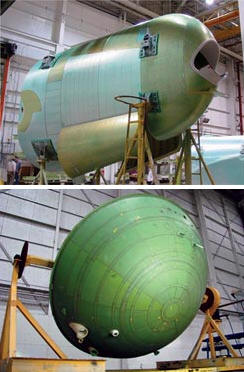 |
|
|
|
|
|
|||
|
By Daniel Baxter |
||||
 |
March 9, 2010 –
Weighing as much as a small elephant and spanning more than 57 feet, the
largest of the 747-8 fuselage panels that
From a
manufacturing standpoint, one of the biggest changes on the 747-8 versus
the 747-400 is the increased size of the fuselage panels. This feature
had the biggest impact on Vought as the company had to reconfigure both
the
Fuselage Panels,
the skins for these panels come from
Fast forward and
the frames are fastened to the skins, final installations are done, and
the panels are ready for painting. The heavy monorail takes the panels
to the painting area where they are painted while still hanging on the
monorail. This same rail then takes the panels to the shipping area
where they are loaded into new shipping fixtures configured specifically
for these panels. They are then loaded into the rail car with the use of
overhead cranes and forklifts. It is interesting to note that the
railcar is actually parked inside the building. |
|||
|
A ship set is
eight panels—three lower panels and five upper panels and the current
move rate is one ship set delivery every 14 days. Section 48 consists of
the upper and lower lobe, the aft body, and the pressure dome. This is
an interesting shipment because the final structures that are loaded
into the railcar look nothing like the hundreds of details that go into
their assembly. Take the aft body or tail cone, for instance. Looking
like its name implies, the tail cone is made up of hundred of items. The
aft body is where the APU, or auxiliary power unit, is located on the
plane. |
||||
|
Resembling a
gigantic bowl, the pressure dome is another piece that is assembled
piece by piece and evolves into the final structure you see in the photo
on next page. “This structure is used to plug the rear end of the
pressurized cabin and is assembled by a four person crew with over 60
years of combined aircraft assembly experience,” said production
supervisor Tony Richie.
|
||||
| ©AvStop
Online Magazine
Contact
Us
Return To News
|
||||
|

